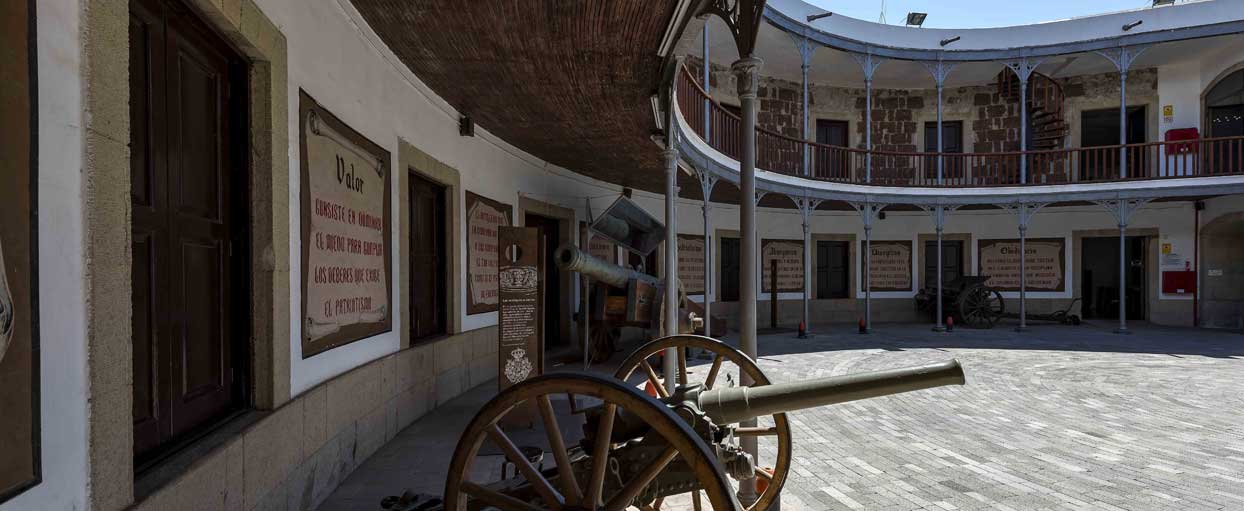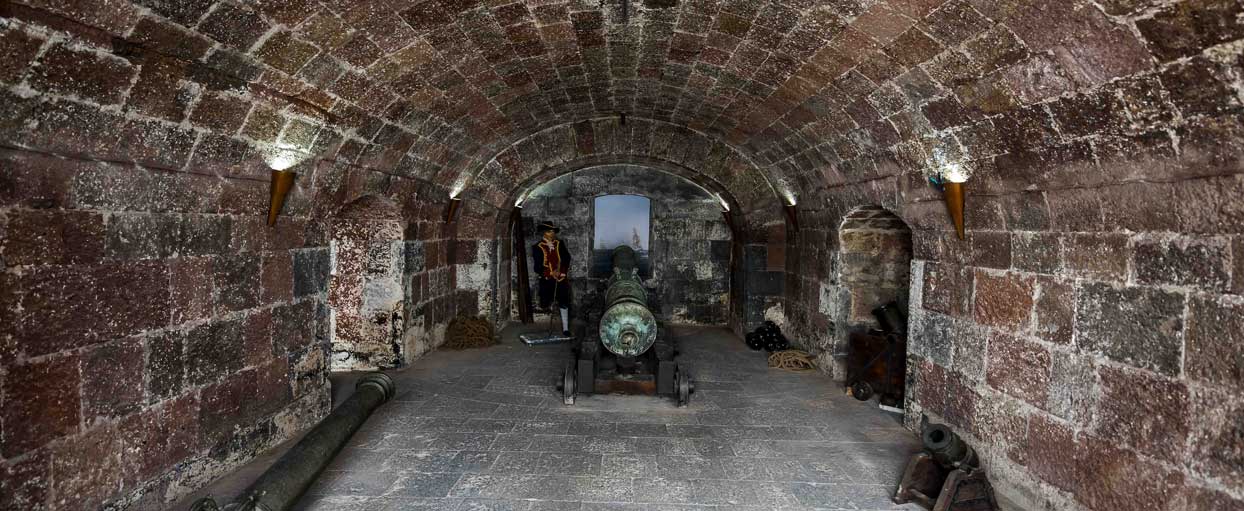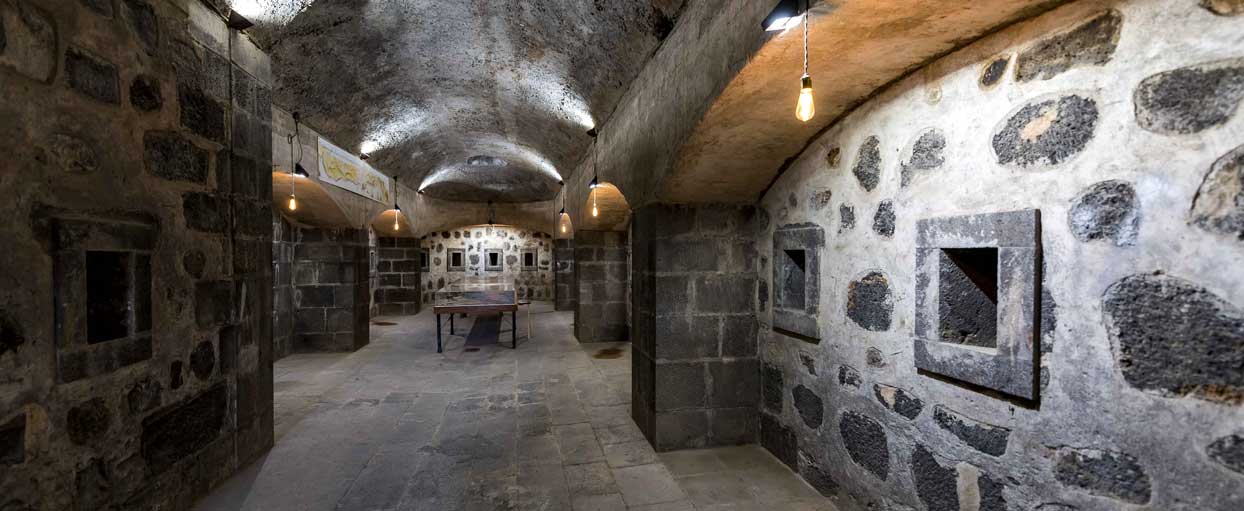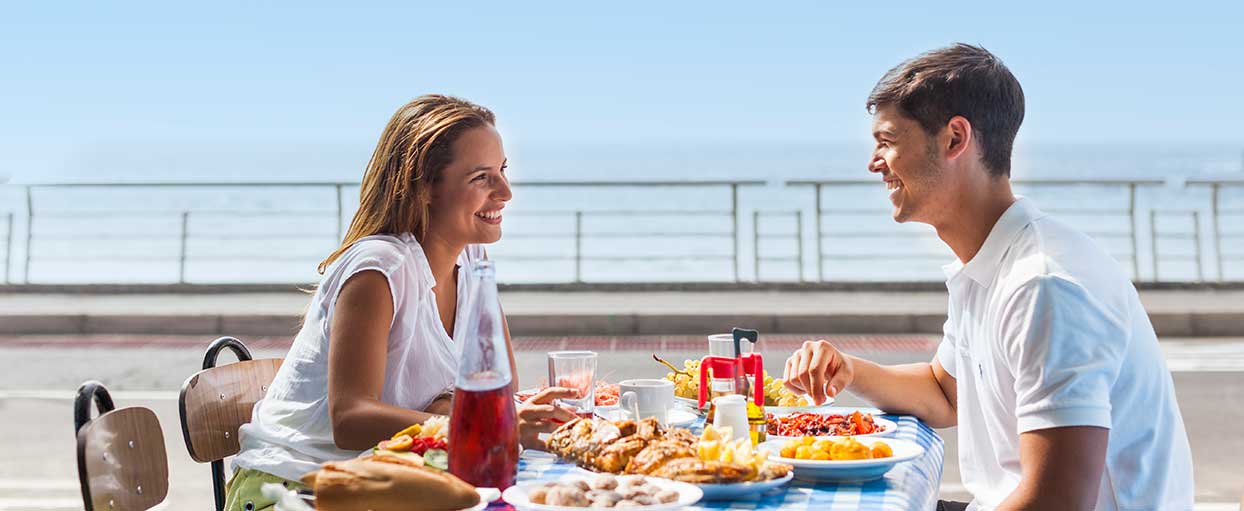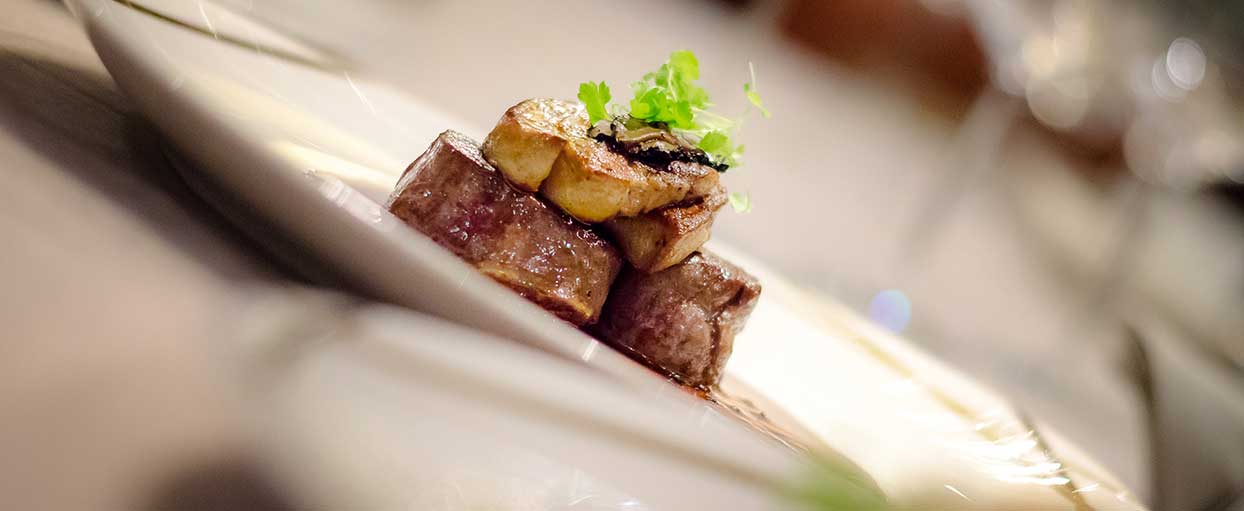A part of the area covered by this zone of the city is the Historic Site of El Toscal, which is aligned around three main axes heading south to north: Calle de la Rosa, Calle Santiago and Calle San Miguel.
Along Avenida Francisco la Roche you can find a wide range of gastronomy and leisure. On the other hand, at the end of this Avenue you will find the road that leads to the neighbourhood of San Andrés, Las Teresitas Beach and Anaga Rural Park (declared a Biosphere Reserve by UNESCO).
In this zone of the city it is worth highlighting the following places:
ALMEIDA FORTRESS AND MILITARY MUSEUM
North of the city centre, at the end of Calle San Francisco is a more or less triangular-shaped promontory that dropped sharply down El Naciente over what was previously called Roncadores beach, along the edge of which ran the path of San Andrés. Its shortest side faced the city and the earth part overlooked the ravine of Ancheta, which shortly before reaching the sea joined -and still joins under Las Ramblas- with that of La Leña, resulting in a single channel at its mouth. That more or less flat and shallow area where the waves broke, was initially called Playa del Varadero (boatyard beach), as it was where ships were built and repaired in the 16th century. The pilot and owner of one of those boats was Juan de Almeida, and it is very possible that the current place is named after this figure, as was the case with the Cove of Blas Díaz and the Ravine of Santos.
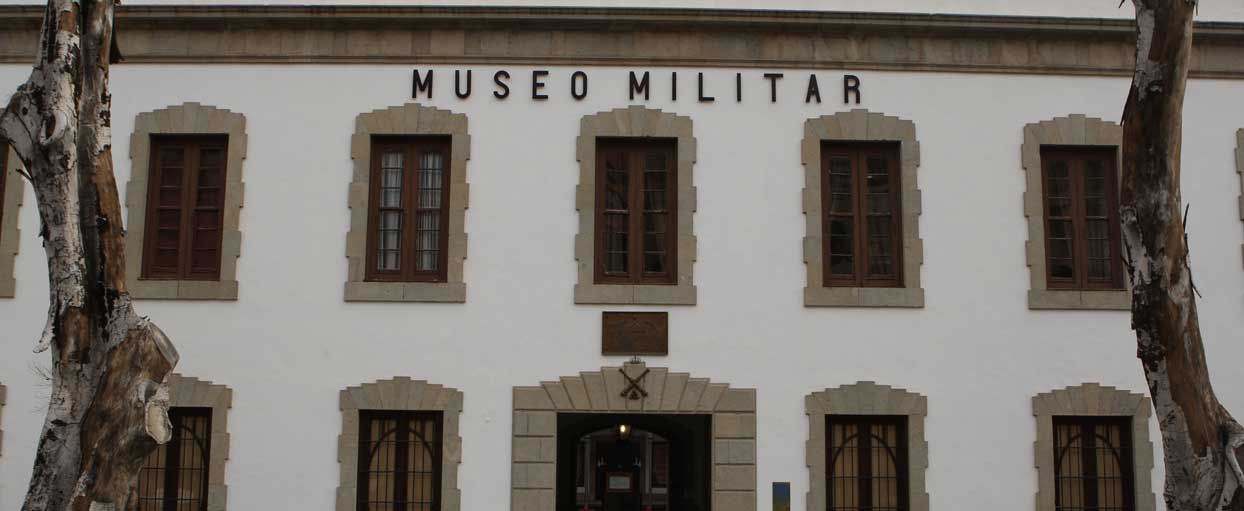
On the side overlooking the sea, since at least the 17th century there has been a vegetable garden named Huerta de los Melones, and the path leading from it, which climbed the slope alongside the right-hand side of the Ancheta ravine was named after it, as was the artillery battery on the same side of the ravine, the Los Melones battery. This is the first precedent of Almeida Fortress, whose construction began in 1859 under the management of the General of the Engineer Unit Salvador Clavijo y Plo, with two main objectives. Firstly, faced with the fact that war ships had powerful artillery that could destroy an entire open gun emplacement or one barely defended behind battlemented parapets with a single hit, it was essential to protect coastal defences facing such attacks with strong fortifications. Secondly, for the first time there was a need to protect the plaza from both sea and land attacks, in case the enemy managed to land via other entry points, as had occurred with Nelson´s first assault on the Bufadero. Had Clavijo´s project been fully carried out, Santa Cruz would have had the most significant fortification in the Canaries, but financial restrictions made it impossible to be completed.
At present, what remains of the entire defensive complex is the central building, the underground casemates of the sea front and little else. In memory of the place´s past activity, the adjoining street is named Calle del Saludo (Salute Street), in remembrance of the salutes that were performed there, from the wall overlooking the sea, to the ships reaching port.
With the construction of several pavilions for housing troops and services, for years the place served as the quarters of the Mixed Artillery Regiment no.93 until it was moved, and it is currently the headquarters of the Centre of Military History and Culture and the Military History Museum of the Canaries.
The Centre acts as a focal point and coordinator for all the cultural activity of the Armed Forces in the Canaries and it has collaboration agreements with the universities of La Laguna and Las Palmas de Canaria. It carries out notable work in the field of publications and organisation of conference series, covering historical and cultural issues in addition to military ones. The Military History Museum operates under the centre. It is one of the best in the country, and was founded by Colonel Juan Arencibia de Torres in 1988, when he was in charge of the regiment.
In the rooms of the former fortress, the public can view countless testimonies, materials, pictures and documents from the history of the Canaries, notably including the monumental model of Santa Cruz de Tenerife which represents the city that the Englishman Vice Admiral Horatio Nelson attempted to storm in 1797, including audio-visual effects. It is also possible to view the famous “El Tigre” cannon temporarily on display in the area under Plaza de España, and the British flags captured from the enemy during their attempt to conquer the island.
These rooms are no longer big enough to exhibit all the available material, so a solution for fitting out the underground casemates -which have an original building typology- is now being sought for a necessary extension. In any case, it is necessary to bear in mind that both the central building and the casemates, once properly restored, are in themselves elements that constitute a part of the wealth of museum treasures in the area.
On the other hand, the entire area of the former quarters is an integral part of the museum, as the heavy materials which do not fit into the display rooms are exhibited outside.
The pavilions which once housed the troops and services of the Artillery Regiment have been properly fitted out and are now home to a large library of historical and military material and the comprehensive Historical Military Archive, containing two million documents made available to researchers and those interested in historic matters, who can use the study and consulting rooms.
LOS LAVADEROS (WASH HOUSES)
During the first two centuries of its existence, the inhabitants of Santa Cruz who lacked wells or cisterns in their homes had to do their laundry by using the currents of the ravines and gullies. This situation was alleviated in 1706 when residents were provided with a public fountain that they could take water from. Despite this, the custom of washing in the ravines remained in force, and it was not until 1820 that the municipal representative Vicente Martinón asked the Council to build public wash houses, an initiative that took more than twenty years to come to fruition.
In 1835 an agreement was reached to request a license from the King to apply to the construction of municipal wash houses, for the time required, half of the taxes charged on wine and spirits in order to pay for the maintenance of the public drains. The following year, the commissioned councillor, Gregorio Asensio Carta, presented the project with a budget and requested that the site for its construction be allocated. The Council took a long time to decide on a location, and another three years to provide a suitable plot of land at the side of the Ancheta ravine, land that was purchased from the Grandy family, right in the place where the drain supplying the city reached to.
However, financial problems and the difficulty supplying wood for construction, delayed its opening until 1842. The revenue from the new facility was auctioned every year for a modest sum that was used to swell the municipal coffers, however the municipality often had to administer the wash houses due to a lack of bidders.
This point was assigned as the terminal for the measurements carried out periodically to determine possible losses from the drain, between the volume that flowed from the source of Mount Aguirre and that which reached the city, which sometimes barely exceeded fifty percent. Throughout its not very dazzling history -complaints due to a lack of hygiene, water restrictions, lack of maintenance, etc.- from 1900 on the facilities were occasionally assigned to a wide range of uses, such as a warehouse, stable for stallions or a public kitchen during epidemics.
The installation resulted in the neighbourhood that now bears its name – Los Lavaderos- founded on the right-hand side of the ravine. Created with a square floor plan, it has sixty basins, fifteen for slapping laundry, and the cistern is located in the centre. It is a special example and authentic relic of unique industrial architecture in the Canary Islands. Following restoration, it is in quite a good state of conservation and remains a municipal property. It is currently used as an art gallery and exhibition space named “Los Lavaderos” (The Wash Houses) and is located on Calle Carlos Chevilly.
Hotel Náutico
It is located on Avenida Profesor Peraza Ayala no. 13. It was opened in 1990 and renovated in 2006. It has a total of 40 rooms.
[/tabitem] [tabitem]
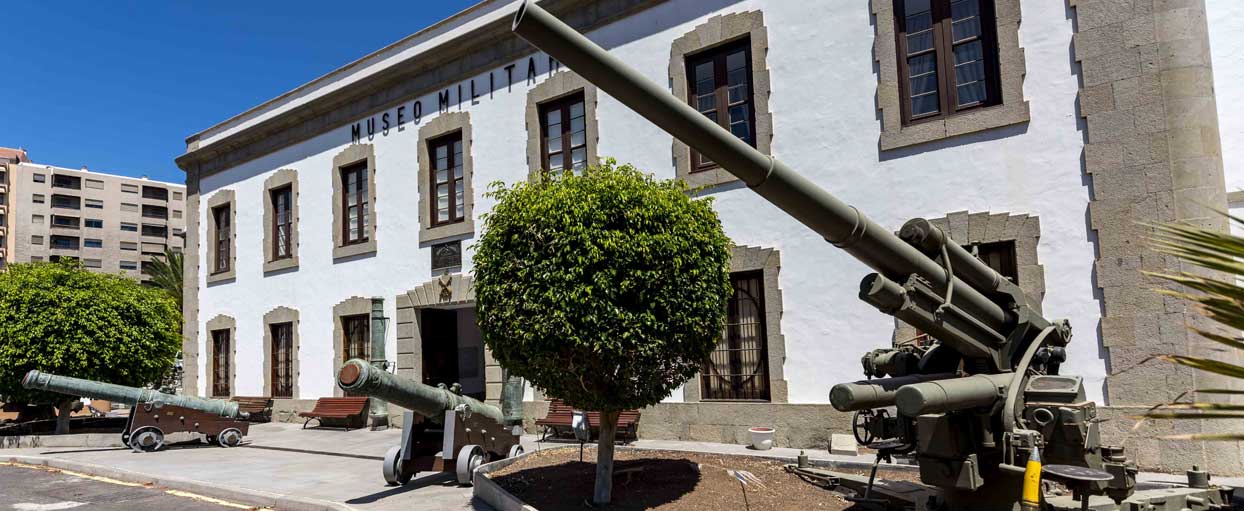
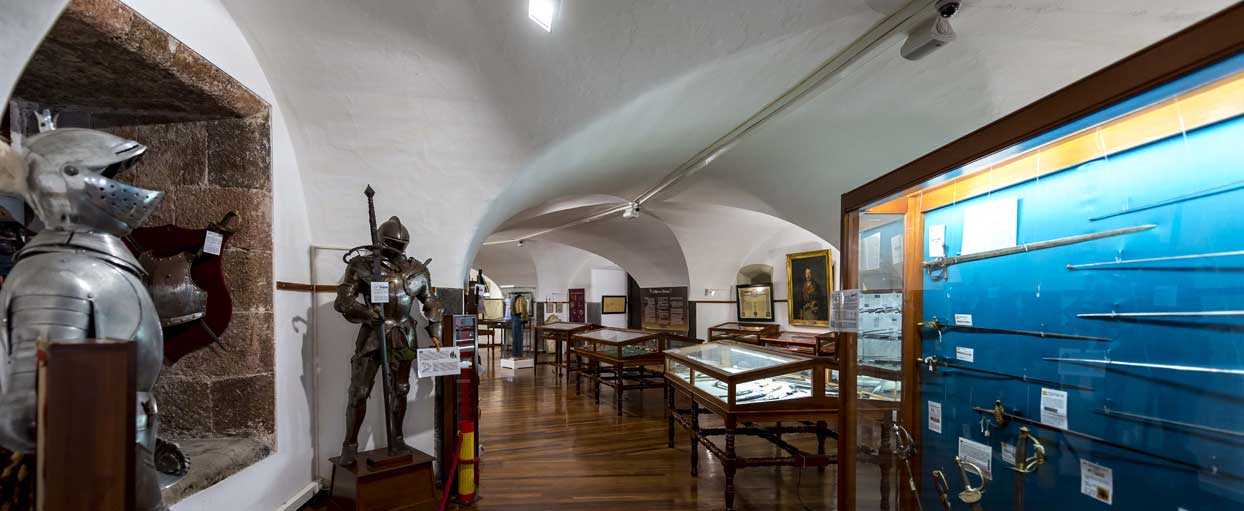
SHOPPING:
With an average temperature of 21 degrees all year round, Santa Cruz is the perfect place to shop in the most extensive open shopping area of the island. Small shops and big brands mingle in an outdoor setting where locals and visitors turn shopping into a unique experience. There is a great variety of shops, cafés, bars, and restaurants to spend a pleasant day browsing and relaxing. The city has the best boutiques and international brands with the latest fashion trends on display in their shop windows. Throughout the city’s shopping streets, large department stores and shopping malls coexist with traditional, small shops where a personal shopping experience and product quality are in the forefront. All of this is wrapped up in a pleasant, friendly atmosphere that makes you want to stroll along the city’s streets, parks, squares and gardens and to sit down to have a drink at any of its many bar terraces.
The shops’ and restaurants’ closeness to each other turns visiting Santa Cruz into a unique experience. The city is easy to access and equipped with enough parking and public transport services: trams, buses, and taxis.
We suggest you see the city by taking some of the following shopping routes:
Route 1 City Centre: Calle Pérez Galdós, calle Viera y Clavijo, calle Méndez Núñez, calle Pi y Margall, calle Suárez Guerra, calle El Pilar, shopping centre “Centro Comercial Parque Bulevar”, calle La Rosa and nearby streets. Enjoy this shopping experience in an area where you can find all kinds of stores offering clothing, accessories, footwear, jewellery, watches, perfumes… This route contains a great number of boutiques showcasing leading brands, with exquisite service and a wide range of unique designs.
Route 2 City Centre: Plaza de La Candelaria, calle Castillo, calle Imeldo Serís, calle Valentin Sanz, calle Bethencourt Alfonso and nearby streets. In the heart of the city you will find the street calle Castillo, a traditional shopping street with all kinds of international franchises and fashion retail chains. The route follows this street, which begins in Plaza de Candelaria and ends at Plaza Weyler.
Route Ramblas: Plaza Weyler, Rambla Pulido, Rambla de Santa Cruz and nearby streets. This route is characterized by a concentration of the commercial activity around both Ramblas: Rambla de Santa Cruz and Rambla de Pulido. There you will find a wide range of shops characterized by the kind service and the quality of products. Along the Rambla de Santa Cruz you can enjoy an exhibition of Sculptures in the Street, which makes the shopping experience much more enjoyable.
Route Shopping Centres: This route is characterized by the presence of large department stores and shopping malls around which one can find a wide array of smaller shops and restaurants to suit all tastes. The main streets are Avenidas Tres de Mayo and Manuel Hermoso Rojas, calle Álvaro Rodríguez López, calle Aurea Díaz Flores and Avenida La Salle. Along this route you can enjoy a wide variety of leisure opportunities inside the shopping centres (cinema, restaurants and personal services) as outdoors (Auditorio de Tenerife Adán Martín, Recinto Ferial de Tenerife, Parque Marítimo César Manrique and Palmetum).
Route Market “Nuestra Señora de Africa”: La Recova, Rambla Azul, shopping centre Recova and Rastro de Santa Cruz (only Sundays). The Market’s shopping area is one of the busiest commercial districts on Santa Cruz. Its central nucleus is the Market of Santa Cruz de Tenerife, or La Recova. It has been open since 1944 and is the successor of the Old La Recova, which goes back to the 19th century. Here you can find the freshest foods from the Canary Islands and from all over the whole world. It specializes in fruit and vegetables, meats and fish, although you can purchase all sorts of foods there, as well as typical products.
The Neo-Colonial building that houses La Recova, is arranged over two large floors, with open patios where you can take a pleasant stroll and enjoy admiring the great variety of fresh foods for sale. Inside you will find a Café with terrace, a place to rest and enjoy food and all types of drinks. Opening hours of the Market Nuestra Señora de Africa are Monday to Saturday from 06 a.m. to 2:00 p.m., and Sundays from 7:00 a.m. to 2:00 p.m.
Next to the market you will find La Rambla Azul, its opening hours are from Monday to Sunday 9 a.m. to 2 p.m. There is also the Shopping Center with more than 40 shops and cafeterias, it opens from Monday to Saturday 9 a.m. to 9 p.m. and Sundays from 9 a.m. to 3 p.m.
Sundays morning are the days that the ‘Rastro,’ the large street market of Santa Cruz, is held at Avenida José Manuel Guimerá, surroundings of the open market Recova and Calle Bravo Murillo. Here you can find a great variety of first and second hand articles, antiques, clothes and fashion accessories in a festive and friendly environment.
GASTRONOMY:
Santa Cruz is the heart of Tenerife and as such it is the home of a range of food and drinks. All parts of the world are represented in the municipality. It’s a place where the food sector has experienced a remarkable growth in the last few years and the zone is known for being a metropolitan area that is home to two stars from the prestigious Michelin Guide.
The gastronomy is undoubtedly part of the local character of a culture. In this sense, the Canary Islands can proudly say that their cuisine is both simple and original in nature and that this is true in terms of the choice of ingredients and how dishes are prepared, with the Islands’ cuisine being based on the Guanche heritage, but also having a clear Spanish influence.
However, despite its simplicity, traditional Canarian cuisine is authentic and rich in flavours that give it a personality of its own – a personality that has been influenced by the Island Chain’s climate and the use of the products readily available in its sea and on its land.
Among the ingredients of traditional Canarian cuisine, some of the most important are products from the sea, such as fish and shellfish like the “vieja” (Mediterranean parrotfish), a white fish with a mild flavour, the “choco” (cuttlefish), a type of squid with a larger size, and the “cherne” (wreckfish), a fish that is consumed salted or as a stew.
In terms of foods from the land, the sweet potato and the potato are the indisputable companions to meat and fish, with the potato being famous in its “papas arrugadas” form (“Canarian wrinkly potatoes” – boiled potatoes with their skins left on). Vegetables such as the tomato, onion, garlic, varieties of peppers, squash, zucchini (or “bubango”), watercress, coriander, and parsley can be used in soups, stews, and in the preparation of the famous Canarian “mojo” sauce in its two versions: green (containing coriander) and red (“mojo picón,” containing pepper).
In terms of meats, noteworthy are dishes based on pork, rabbit, and kid goat, all of which can be prepared with a sauce as a stew, fried, or roasted.
Goat’s milk is the basic ingredient of the cheeses from the Canary Islands, which are consumed fresh, semi-cured, cured, and even smoked.
But there is a Canarian food product that is derived from grains like corn, wheat, and barley and which has become established as a “symbol” of the gastronomic culture of the islands. It is known as “Gofio” (a fine mixture of the aforementioned grains previously toasted and ground) and it has multiple culinary applications, as it has acted as the “bread of the canaries” (kneaded with water and not cooked), it can be consumed “scrambled” with broth (escaldón) or a stew, and it can even be mixed with honey and almonds to act as a desert. Its consumption is so widespread that, in many homes, it is customary to mix gofio with milk and sugar and use it for breakfast. Other products that complement the cuisine of the Canary Islands are the local wines from the region, with Tenerife being the perfect example. The island is divided into five wine-producing districts, and Santa Cruz de Tenerife is located in the Tacoronte-Acentejo district. Tenerife’s gastronomy brings together the products and dishes that are most representative of Canarian cuisine with a wide range of dining establishments.
One of the increasingly popular trends over the past few years is the diversification of traditional cuisine, giving rise to a new, more creative and contemporary branch of cooking known as “signature cooking.” While this type of cuisine keeps its base through the use of traditional products, it innovates by introducing new and exotic ingredients (many of them foreign) and a mix of flavours that bring originality to the recipe. Likewise, emphasis is placed on the dishes’ presentation, turning them into artistic creations done by expert chefs.
The dining sector of the municipality of Santa Cruz de Tenerife has it all. Visitors can find the best of the traditional cuisine mostly in restaurants or “guachinches” around the Anaga area. In the rest of the city, there are establishments that offer everything from traditional Canarian cuisine to exquisite “signature cooking” and more creative dishes, without forgetting the wide range of regional Spanish specialties, bars serving “tapas,” and a great variety of restaurants that offer international cuisine.
[/tabitem][/cq_vc_tabs]

